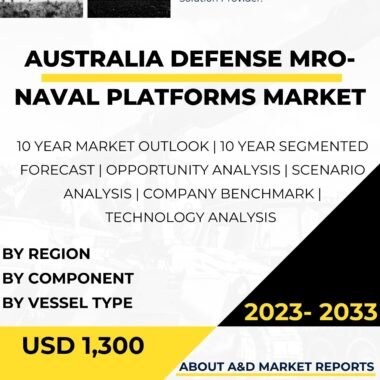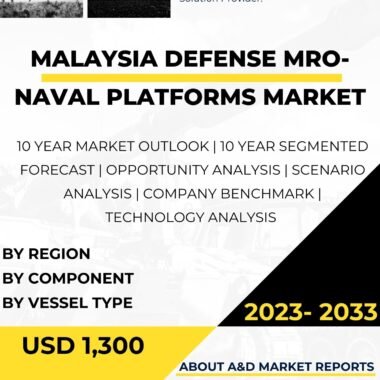Description
In the United States’ defense industry, Maintenance, Repair, and Overhaul (MRO) services for naval platforms play a crucial role in ensuring the reliability, safety, and operational readiness of military ships and submarines. MRO encompasses a wide range of activities, including inspections, repairs, upgrades, and overhauls, aimed at extending the service life and optimizing the performance of naval assets. These services are essential for maintaining maritime superiority, supporting naval operations, and ensuring the longevity of the United States’ naval fleet. This article will explore the development, types, applications, and significance of defense MRO services for naval platforms in supporting the nation’s defense capabilities and maintaining the effectiveness of its maritime assets.
The need for MRO services for naval platforms became evident with the expansion of naval warfare and the use of warships and submarines in military operations. As naval technology advanced, the complexity of naval platforms increased, necessitating specialized maintenance and repair services to keep them operational.
During World War II, the demand for MRO services escalated as naval vessels were extensively used in combat operations. The establishment of dedicated maintenance units and facilities ensured that naval platforms could be quickly repaired and returned to service.
In the post-war era, the development of advanced naval platforms and more sophisticated technologies introduced new challenges in maintaining naval assets. The increasing complexity of naval platforms demanded higher levels of expertise and technology in MRO services.
Today, defense MRO services for naval platforms are conducted by various entities, including military maintenance units, original equipment manufacturers (OEMs), defense contractors, and private shipyards. These services encompass different levels of maintenance, each contributing to the overall operational readiness and effectiveness of naval assets.
Organizational-level maintenance involves routine inspections, servicing, and component replacements performed by the ship’s crew or in designated naval maintenance facilities. This level of MRO addresses day-to-day maintenance and repairs to maintain the vessel’s operational capability.
Intermediate-level maintenance includes more comprehensive inspections and repairs, usually performed in designated naval repair facilities or shipyards. This level of MRO addresses more complex issues and may involve the replacement of major ship components.
Depot-level maintenance, also known as overhaul, is the most extensive level of MRO for naval platforms, involving a complete disassembly, inspection, and refurbishment of the vessel. Depot-level maintenance is performed periodically to extend the service life of naval platforms and ensure they meet the latest performance and safety standards.
Additionally, modernization and upgrade programs are an integral part of defense MRO services for naval platforms. As naval technology evolves, ships and submarines may require improvements and adaptations to maintain their effectiveness in maritime operations.
The significance of defense MRO services for naval platforms lies in their critical role in maintaining operational readiness, safety, and effectiveness of military maritime assets. Effective MRO services are essential for ensuring the availability of naval platforms for maritime operations and response to emerging threats.
Regular maintenance and inspections are necessary to detect and address potential issues before they escalate into more significant problems. By identifying and rectifying maintenance requirements proactively, MRO services reduce the risk of equipment breakdowns during critical naval operations.
Moreover, MRO services contribute to the overall safety and reliability of naval platforms. Ensuring that ships and submarines are properly maintained and inspected minimizes the risk of accidents and incidents caused by technical failures or malfunctions.
Additionally, MRO services play a key role in extending the service life of naval platforms, optimizing the return on investment in defense assets. Through timely repairs and overhauls, naval platforms can remain in service for longer periods, reducing the need for frequent replacements and acquisitions.
In the context of defense budgets and resource management, efficient MRO services offer significant cost savings compared to procuring new naval assets. By maintaining existing platforms in top condition, the U.S. Navy can allocate resources strategically and invest in modernization efforts.
The ongoing development and advancement of defense MRO services for naval platforms involve continuous research and investment in advanced technologies, equipment, and training. The U.S. Department of Defense (DoD) collaborates with OEMs, defense contractors, research institutions, and naval maintenance organizations to improve MRO capabilities and address emerging challenges and requirements.
Advancements in predictive maintenance technologies, such as condition-based monitoring and health management systems, enable early detection of potential issues and facilitate proactive maintenance planning. By implementing these technologies, maintenance activities can be optimized, reducing downtime and improving naval platform availability.
Moreover, the adoption of digitalization and data analytics in MRO services enhances data-driven decision-making and enables more efficient maintenance practices. By leveraging data from ship sensors and monitoring systems, maintenance technicians can better assess the health of naval platforms, enabling more targeted and effective maintenance interventions.
Challenges in defense MRO services for naval platforms include managing the increasing complexity of modern naval equipment and keeping up with the pace of technological advancements. The integration of advanced electronics, sensors, and stealth technology in new naval platforms demands specialized expertise and access to advanced testing and diagnostic tools.
Additionally, the obsolescence of certain ship components and technologies can pose challenges in MRO services, requiring innovative solutions for component replacements and upgrades.
To address these challenges, the DoD emphasizes the importance of continuous training and skills development for naval maintenance technicians, ensuring they have the knowledge and expertise to handle the latest naval platform technologies and systems.
Furthermore, the defense industry focuses on developing more sustainable MRO practices to minimize the environmental impact of maintenance operations. Efforts are underway to explore eco-friendly materials, processes, and waste management strategies in naval MRO activities.
In conclusion, defense MRO services for naval platforms are indispensable for ensuring the reliability, safety, and effectiveness of military maritime assets in the United States. These services encompass various levels of maintenance, from routine inspections and repairs to extensive overhauls.
By maintaining naval platforms in top condition, MRO services contribute to the operational readiness and mission success of the U.S. Navy.
The ongoing development and advancement of defense MRO services involve continuous research and investment in advanced technologies, training, and sustainability practices.
Through effective MRO services, the U.S. Department of Defense can optimize the lifecycle and performance of its naval fleet, supporting national defense objectives and maintaining maritime superiority in an ever-evolving and challenging security landscape.




